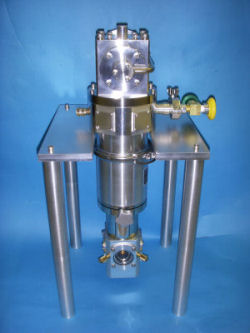Applications | Matrix isolation
Matrix isolation systems require the following components:
- LHe cryostat or closed-cycle cryostat with the sample cooled in a vacuum
- Four o-ring sealed windows
- Optical vacuum shroud that can rotate ±180° under vacuum
- Two o-ring compression seals to function as gas introduction ports
- Optical sample holder that can hold a small (<1 in diameter) substrate
Examples of closed-cycle cryostats for matrix isolation
Matrix isolation is a technique for performing optical spectroscopy, usually in the UV/visible or IR range.
It involves depositing a gas mixture of a substance of interest and a matrix gas onto a substrate at low temperatures for a certain amount of time. Spectroscopy is then performed on the frozen matrix. When the measurement is done, the frozen gasses are pumped away while the substrate and the cryostat are warmed up.
This technique is particularly useful for studying highly reactive samples such as ions or free radicals. At room temperature, these types of samples would immediately react with each other to form a different molecule before a spectroscopic measurement could be taken on the original sample.
Surrounding the reactive samples with the non-reactive matrix gas molecules and then freezing the mixture in place keeps the samples isolated from each other so they cannot react. The sample remains in its original form, and it can be studied for as long as everything remains frozen.
Common choices for the matrix gases are argon for studies in the IR and neon for studies in the UV/visible range. Common substrates are cesium iodide for IR studies and sapphire for UV/visible studies.
As a general rule of thumb, the freezing temperature (in K) of the matrix material should be at least twice the base temperature of the cryostat. A 4 K cryostat is usually preferred when using neon as the matrix gas (the freezing temperature of Ne is 24.5 K), while a less expensive 10 K system is acceptable for argon (the freezing temperature of Ar is 83.9 K).
The gas introduction ports are usually o-ring compression seals with capillary tubes connected to the source of the sample and matrix gas. The customer may specify the diameter of these tubes.
The most common choice for a window material on the room-temperature window block is UV-grade fused silica. However, the windows are usually o-ring sealed, so they can be easily swapped with other materials for different transmission ranges.
For the experiment, the cryostat is evacuated and cooled to base temperature, and a reference spectrum is measured. The sample and the matrix gas are then introduced simultaneously through the gas introduction ports. The mixture of the sample and matrix gas will freeze to the cold substrate.
Once the deposition is complete, the window block is rotated 180° so that the capillary tubes for the sample and matrix gas are on the backside of the substrate and not in the way of the optical measurement. The spectroscopic measurement is then performed on the sample. When the sample measurement is done, the cryostat is warmed up, and the sample + matrix gas will be pumped out of the cryostat when they return to the gaseous state.
Existing designs include:
- Continuous flow cryostat with the sample located in vacuum — ST-100 Series cryostats
- Closed-cycle refrigerator with the sample located in vacuum — CCS-100 Series cryostats
Contact us today for details of how our systems can be integrated into your laboratory.




